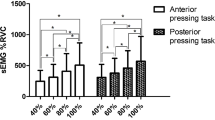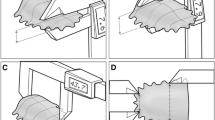Abstract
Tongue strength has an important role in the swallowing process, and previous research has suggested that tongue position, concerning the craniomandibular region, could affect the oral function. This study aimed to evaluate the strength and endurance of three areas of the tongue in three experimentally induced craniocervical postures. A cross-sectional study with a nonprobabilistic sample of 37 participants (mean age: 3.85 ± 3.64 years; 20 men, 17 women) was performed. Tongue strength and endurance were assessed using a pressure device entitled Iowa Oral Performance Instrument (IOPI), in three different craniocervical positions: neutral head position (NHP), anterior head translation—or forward head position (FHP), and posterior head translation—or retracted head position (RHP). Measurements taken using the IOPI system showed significant differences in tongue strength for the anterior (p = 0.015) and middle areas of the tongue (p = 0.01). Significant differences were observed in analysis of variance (ANOVA) in the FHP (p = 0.02) and NHP (p = 0.009). The results of tongue endurance measurements showed statistically significant differences for FHP (p = 0.001), NHP (p = 0.00), and RHP (p = 0.007). The craniocervical position influences tongue strength, especially in the anterior and middle tongue areas, concerning the posterior, and, in the anterior and neutral head posture, regarding the retracted position. No differences were found in tongue resistance between the various craniocervical positions, but differences were found in resistance between the different tongue areas.





Similar content being viewed by others
References
Zhao L, Monahan R. Functional assessment of the stomatognathic system. Clin Plast Surg. 2007;34:e1–e9.
Stål P, Marklund S, Thornell LE, et al. Fibre composition of human intrinsic tongue muscles. Cells Tissues Organs. 2003;173:147–61.
Sakamoto Y. Configuration of the extrinsic muscles of the tongue and their spatial interrelationships. Surg Radiol Anat. 2017;39:497–506.
Clark HM, Henson PA, Barber WD, et al. Relationships among subjective and objective measures of tongue strength and oral phase swallowing impairments. Am J Speech-Lang Pathol. 2003;12:40–50.
Matsuo K, Palmer JB. Anatomy and physiology of feeding and swallowing: normal and abnormal. Phys Med Rehabil Clin N Am. 2008;19(691–707):vii.
Mioche L, Hijemae K, Palmer J. A postero-anterior videofluorographic study of the intra-oral management of food in man. Arch Oral Biol. 2002;47:267–80.
Gingrich LL, Stierwalt JAG, Hageman CF, et al. Lingual propulsive pressures across consistencies generated by the anteromedian and posteromedian tongue by healthy young adults. J Speech Lang Hear Res. 2012;655:960–72.
Robinovitch SN, Hershler C, Romilly DP. A tongue force measurement system for the assessment of oral-phase swallowing disorders. Arch Phys Med Rehabil. 1991;72:38–42.
Sakamoto Y. Structural arrangement of the intrinsic muscles of the tongue and their relationships with the extrinsic muscles. Surg Radiol Anat. 2018;40:681–8.
Schimmel M, Ono T, Lam OLT, et al. Oro-facial impairment in stroke patients. J Oral Rehabil. 2017;44:313–26.
Kim HD, Choi JB, Yoo SJ, et al. Tongue-to-palate resistance training improves tongue strength and oropharyngeal swallowing function in subacute stroke survivors with dysphagia. J Oral Rehabil. 2017;44:59–64.
Valentim AF, Furlan RM, Perilo TV, et al. Relação entre a percepção da posição de língua pelo indivíduo e medidas de força da língua nos dentes. CoDAS. 2016;28:546–50.
Hiiemae KM, Palmer JB. Tongue movements in feeding and speech. Crit Rev Oral Biol Med. 2003;14:413–29.
Yamada R, Ogawa T, Koyano K. The effect of head posture on direction and stability of mandibular closing movement. J Oral Rehabil. 1999;26:511–20.
Sanders RD. The trigeminal (V) and facial (VII) cranial nerves: head and face sensation and movement. Psychiatry (Edgmont). 2010;7:13–6.
Liu Y, Broman J, Zhang M, et al. Brainstem and thalamic projections from a craniovascular sensory nervous centre in the rostral cervical spinal dorsal horn of rats. Cephalalgia. 2009;29:935–48.
Milidonis MK, Kraus SL, Segal RL, et al. Genioglossi muscle activity in response to changes in anterior/neutral head posture. Am J Orthod Dentofacial Orthop. 1993;103:39–44.
Hanamoto H, Kadono K, Boku A, et al. Both head extension and mouth opening impair the ability to swallow in the supine position. J Oral Rehabil. 2014;41:588–94.
Sakuma T, Kida I. Relationship between ease of swallowing and deglutition-related muscle activity in various postures. J. Oral Rehabil. 2010;37:583–9.
La Touche R, París-Alemany A, von Piekartz H, et al. The influence of cranio-cervical posture on maximal mouth opening and pressure pain threshold in patients with myofascial temporomandibular pain disorders. Clin J Pain. 2011;27:48–55.
Ballenberger N, von Piekartz H, Paris-Alemany A, et al. Influence of different upper cervical positions on electromyography activity of the masticatory muscles. J Manip Physiol Ther. 2012;35:308–18.
Ohmure H, Miyawaki S, Nagata J, et al. Influence of forward head posture on condylar position. J Oral Rehabil. 2008;35:795–800.
Nicosia MA, Hind JA, Roecker EB, et al. Age effects on the temporal evolution of isometric and swallowing pressure. J Gerontol A. 2000;55:M634–M640640.
Youmans SR, Stierwalt JAG. Measures of tongue function related to normal swallowing. Dysphagia. 2006;21:102–11.
Stierwalt JAG, Youmans SR. Tongue measures in individuals with normal and impaired swallowing. Am J Speech-Lang Pathol. 2007;16:148–56.
Youmans SR, Youmans GL, Stierwalt JAG. Differences in tongue strength across age and gender: is there a diminished strength reserve? Dysphagia. 2009;24:57–655.
von Elm E, Altman DG, Egger M, et al. The Strengthening the Reporting of Observational Studies in Epidemiology (STROBE) statement: guidelines for reporting observational studies. J Clin Epidemiol. 2008;61:344–9.
Lentell G, Kruse M, Chock B, et al. Dimensions of the cervical neural foramina in resting and retracted positions using magnetic resonance imaging. J Orthop Sport Phys Ther. 2002;32:380–90.
Enwemeka CS, Bonet IM, Ingle JA, et al. Postural correction in Persons with neck pain (II. integrated electromyography of the upper trapezius in three simulated neck positions). J Orthop Sports Phys Ther. 1986;8:240–2.
Hanten WP, Lucio RM, Russell JL, et al. Assessment of total head excursion and resting head posture. Arch Phys Med Rehabil. 1991;72:877–80.
Dunleavy K, Neil J, Tallon A, et al. Reliability and validity of cervical position measurements in individuals with and without chronic neck pain. J Man Manip Ther. 2015;23:188–96.
Audette I, Dumas J-P, Côté JN, et al. Validity and between-day reliability of the cervical range of motion (CROM) device. J Orthop Sports Phys Ther. 2010;40:318–23.
Hickey ER, Rondeau MJ, Corrente JR, et al. Reliability of the cervical range of motion (CROM) device and plumb-line techniques in measuring resting head posture (RHP). J Man Manip Ther. 2000;8:10–7.
Garrett TR, Youdas JW, Madson TJ. Reliability of measuring forward head posture in a clinical setting. J Orthop Sport Phys Ther. 1993;17:155–60.
Adams V, Mathisen B, Baines S, et al. Reliability of measurements of tongue and hand strength and endurance using the iowa oral performance instrument with healthy adults. Dysphagia. 2014;29:83–95.
Adams V, Mathisen B, Baines S, et al. A systematic review and meta-analysis of measurements of tongue and hand strength and endurance using the Iowa oral performance instrument (IOPI). Dysphagia. 2013;28:350–69.
Solomon NP, Munson B. The effect of jaw position on measures of tongue strength and endurance. J Speech Lang Hear Res. 2004;47:584–94.
Cohen J. Statistical power analysis for the behavioral sciences. Hillsdale: Lawrence Erlbaum Associates Inc.; 1988.
Vanderwegen J, Guns C, Van Nuffelen G. The influence of age, sex, bulb position, visual feedback, and the order of testing on maximum anterior and posterior tongue strength and endurance in healthy belgian adults. Dysphagia. 2013;28:159–66.
Kennedy D, Kieser J, Bolter C, et al. Tongue pressure patterns during water swallowing. Dysphagia. 2010;25:11–9.
Rassier DE, MacIntosh BR, Herzog W. Length dependence of active force production in skeletal muscle. J Appl Physiol. 1999;86:1445–577.
Rocabado M. Biomechanical relationship of the cranial, cervical, and hyoid regions. J Craniomandib Pract. 1983;1:61–6.
Carroll B, Hunt S, Sheeleigh K, Wnukowski M. The influence of forward head posture on suprahyoid activity during oropharyngeal swallowing: a surface electromyographic analysis. CUNY Academic Works. 2015. https://academicworks.cuny.edu/gc_etds/802.
Yoon WL, Khoo JKP, Rickard Liow SJ. Chin tuck against resistance (CTAR): new method for enhancing suprahyoid muscle activity using a shaker-type exercise. Dysphagia. 2014;29:243–8.
Sze WP, Yoon WL, Escoffier N, et al. Evaluating the training effects of two swallowing rehabilitation therapies using surface electromyography—chin tuck against resistance (CTAR) exercise and the shaker exercise. Dysphagia. 2016;31:195–205.
Leigh J-H, Oh B-M, Seo HG, et al. Influence of the chin-down and chin-tuck maneuver on the swallowing kinematics of healthy adults. Dysphagia. 2015;30:89–988.
Adamo ML, Farrar RP. Resistance training, and IGF involvement in the maintenance of muscle mass during the aging process. Ageing Res Rev. 2006;5:310–31.
Macaluso A, De Vito G. Muscle strength, power and adaptations to resistance training in older people. Eur J Appl Physiol. 2004;91:450–72.
Utanohara Y, Hayashi R, Yoshikawa M, et al. Standard values of maximum tongue pressure taken using newly developed disposable tongue pressure measurement device. Dysphagia. 2008;23:286–90.
Crow HC, Ship JA. Tongue strength and endurance in different aged individuals. J Gerontol A. 1996;51:M247–M250250.
Funding
This research did not receive any specific grant from funding agencies in the public, commercial, or not-for-profit sectors.
Author information
Authors and Affiliations
Contributions
Conceptualization: AP-A, RLT, JC-S. Methodology: AP-A, RLT, AP-A. Formal analysis and investigation: AP-A, RLT, DA-J, LS-M. Writing-original draft preparation: AP-A, RLT, AP-A, DA-J, LS-M, JC-S. Writing-review and editing: AP-A, RLT, AP-A, DA-J, LS-M, JC-S. Supervision: AP-A, RLT.
Corresponding author
Ethics declarations
Conflict of interest
The authors declare that they have no conflicts of interest.
Additional information
Publisher's Note
Springer Nature remains neutral with regard to jurisdictional claims in published maps and institutional affiliations.
Rights and permissions
About this article
Cite this article
Paris-Alemany, A., Proy-Acosta, A., Adraos-Juárez, D. et al. Influence of the Craniocervical Posture on Tongue Strength and Endurance. Dysphagia 36, 293–302 (2021). https://doi.org/10.1007/s00455-020-10136-9
Received:
Accepted:
Published:
Issue Date:
DOI: https://doi.org/10.1007/s00455-020-10136-9




